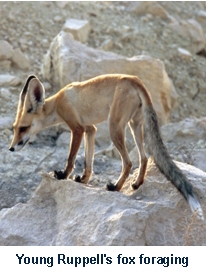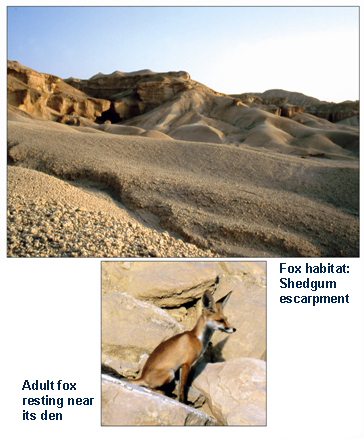|
Culture |


Ruppell's sand fox is a beautiful small carnivore, which is found throughout the Arabian desert regions. Superbly adapted to desert living, this relatively little-known animal is largely nocturnal. Its diet includes small rodents, lizards, insects and birds. The sand fox is an elegant animal that is extremely well-adapted to desert life. It is equally at home in sandy or stony deserts and arid steppe.
Written and photographed by
Dr. Graham R. Lobley
Ruppell's sand fox Vulpes ruppelli occurs across the vast desert zones, from Morocco east to Afghanistan and Pakistan. It is also found in Somalia, Arabia, Sinai and north to the Dead Sea and Iraq. Various subspecies have been recognized within this extensive range; the Arabian fox is designated Vulpes ruppelli sabaea. The sand fox is normally quite independent of water and there are even sight records from within the Rub al Khali, the world's largest sand desert. It is thought to be thinly distributed across most of the Arabian Peninsula, occurring everywhere except in the southwestern and southern mountains. I have been fortunate enough to see these attractive little creatures in several areas of central and eastern Saudi Arabia including Mahazat and Shedgum. The foxes breed in winter and the young become independent at four months. They spend the day in dens, which are burrowed in sand or located among suitable larger rocks.
The fox has a pale sandy-coloured coat with distinctive black patches on the face. The tip of the tail is conspicuously white. The fur is soft, short and dense, and the animal's frame is slighter than the red fox with relatively shorter legs, large broad ears and a long narrow muzzle. The young have pale sandy-coloured necks and upper chest, which turn much darker - almost black in adults. They have fur on the pads of their feet, to protect them from the heat of the sand. The head and body measure up to 50 centimetres and the long tail is up to 40 centimetres. This agile little creature weighs up to 3.5 kilograms. Reports suggest an omnivorous diet with a substantial insectivorous component. Other food includes berries, fruits, lizards, small rodents and carrion. I have also seen a fox catch, pluck and eat a collared dove and play with a beetle before eating it.
 At
Mahazat, Dr.Stuart Warrington and Daniel Lenain undertook an
ecology study of foxes in arid areas. The aim of this project
was an evaluation of the status and ecology of fox populations
in and around the large, fence protected area of the Mahazat
as-Sayd reserve. This was a joint project involving the
University of Hertfordshire, UK, and the National Wildlife
Research Center (NWRC) in Saudi Arabia. The 2,244 square
kilometre Mahazat as-Sayd protected area lies approximately 150
kilometres north-east of the city of Taif and is surrounded by
about 220 kilometres of chainlink fence. Mahazat as-Sayd is a
hot and arid habitat, typical of the central plateau of the
Arabian Peninsula, gently undulating at elevations of 900 to
1,100 metres above sea level. Mahazat was chosen as an area for
various reintroduction programs including the Arabian oryx (Oryx
leucoryx) and the houbara bustard (Chlamydotis undulata macqueeni). It is also a natural breeding stronghold of the
lappet-faced vulture (Torgus tracheleotus), the largest bird of
Arabia. This large study area provided the researchers with an
opportunity to study the recovery of an arid ecosystem now
protected from the pressure of grazing domestic stock and human
disturbance.
At
Mahazat, Dr.Stuart Warrington and Daniel Lenain undertook an
ecology study of foxes in arid areas. The aim of this project
was an evaluation of the status and ecology of fox populations
in and around the large, fence protected area of the Mahazat
as-Sayd reserve. This was a joint project involving the
University of Hertfordshire, UK, and the National Wildlife
Research Center (NWRC) in Saudi Arabia. The 2,244 square
kilometre Mahazat as-Sayd protected area lies approximately 150
kilometres north-east of the city of Taif and is surrounded by
about 220 kilometres of chainlink fence. Mahazat as-Sayd is a
hot and arid habitat, typical of the central plateau of the
Arabian Peninsula, gently undulating at elevations of 900 to
1,100 metres above sea level. Mahazat was chosen as an area for
various reintroduction programs including the Arabian oryx (Oryx
leucoryx) and the houbara bustard (Chlamydotis undulata macqueeni). It is also a natural breeding stronghold of the
lappet-faced vulture (Torgus tracheleotus), the largest bird of
Arabia. This large study area provided the researchers with an
opportunity to study the recovery of an arid ecosystem now
protected from the pressure of grazing domestic stock and human
disturbance.
The fox population studies were based on intensive mark-release-recapture (MRR) techniques in three zones over three years, with some radio-tracking work to research home range. The results of the study are intended to provide a quantitative basis for the formulation of management plans in the protected area and other arid protected areas, to ensure that the conservation of native small carnivores and the restoration of potential prey species are complementary endeavours.
Significantly, the research indicated that the numbers of Ruppell's fox had increased threefold from 1994 to 1998 within Mahazat, and the density in spring 1998 was about 0.68 foxes per square kilometre. Arabian red fox density was about 0.26 per square kilometre. Ruppell's fox density outside the protected area was under a third less than inside Mahazat. This work indicated the significant impact of more intensive land use on the natural habitat outside the reserve. Annual survival rate for Ruppell's fox was estimated to be about 50%, but the oldest individual (a female) recaptured was 5.5 years old. This compares well with the oldest fox in captivity, which lived to 6.5 years. Translocation of some foxes was undertaken, since there was some predation of houbara chicks. It was found that foxes were able to return to Mahazat, unless they were relocated at least 150 kilometres away. On our January visit to Mahazat, an early start revealed a pair of sand foxes close to their burrowed den on an extensive flat plain. The crystal clear early morning light provided memorable first-ever views of these delightful little animals. Soon afterwards, we also enjoyed distant views of a herd of more than 20 Arabian oryx. An earlier fox study at Yalooni in Oman included radio-tracking (Lindsay and Macdonald, 1986), which showed that adults were organised as monogamous pairs. The foxes sheltered by day in dens, which breeding pairs often shared. The vixen always rested in the same den as her cubs. Den sites were frequently shifted, roughly every five days. The foxes sought a den during the hour before sunrise and stayed around until about 30 minutes after sunrise. The foxes resurfaced again about an hour before sunset. These observations are relatively consistent with my own: I found foxes loafing and relaxing near known dens just after sunset and resting near and retreating to their dens up to an hour after sunrise.
Ruppell's sand fox is undoubtedly a beautiful and elegant little animal - a true desert dweller and survivor. Any close encounters with this lovely and remarkable creature will surely leave a lasting impression on the environmentally conscious and patient observer.